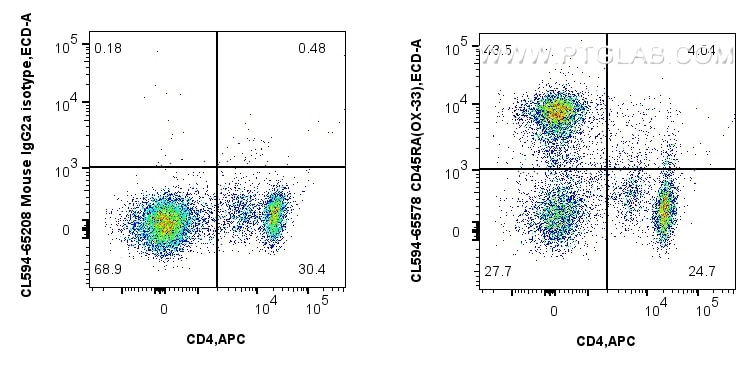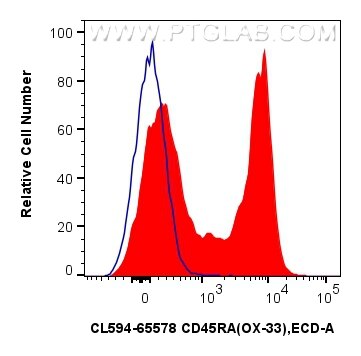Tested Applications
| Positive FC detected in | rat splenocytes |
Recommended dilution
| Application | Dilution |
|---|---|
| This reagent has been tested for flow cytometric analysis. It is recommended that this reagent should be titrated in each testing system to obtain optimal results. | |
| Sample-dependent, Check data in validation data gallery. | |
Product Information
CL594-65578 targets CD45RA in FC applications and shows reactivity with rat samples.
| Tested Reactivity | rat |
| Host / Isotype | Mouse / IgG2a |
| Class | Recombinant |
| Type | Antibody |
| Immunogen | Leukocyte common antigen purified from rat splenocytes Predict reactive species |
| Full Name | protein tyrosine phosphatase, receptor type, C |
| Calculated Molecular Weight | 143 kDa |
| GenBank Accession Number | XM_006249910 |
| Gene Symbol | CD45 |
| Gene ID (NCBI) | 24699 |
| RRID | AB_3673488 |
| Conjugate | CoraLite®594 Fluorescent Dye |
| Excitation/Emission Maxima Wavelengths | 588 nm / 604 nm |
| Form | Liquid |
| Purification Method | Protein A purification |
| Storage Buffer | PBS with 0.09% sodium azide. |
| Storage Conditions | Store at 2-8°C. Avoid exposure to light. Stable for one year after shipment. |
Background Information
CD45, also known as protein tyrosine phosphatase, receptor type C, is a type I transmembrane protein expressed on the surface of all haematopoietic cells with the exception of erythrocytes and platelets (PMID: 3489673; 28615666). CD45 is a pan-haematopoietic cell marker and has been shown to be essential for T- and B-cell activation and signaling (PMID: 9429890; 16378097). CD45 exists as multiple isoforms due to alternative splicing of three exons (4, 5, and 6, designated A, B, and C) in the extracellular domain (PMID: 12414720). CD45RA is expressed on naïve T cells, B cells, and monocytes (PMID: 1830500; 14687231).
Protocols
| Product Specific Protocols | |
|---|---|
| FC protocol for CL594 CD45RA antibody CL594-65578 | Download protocol |
| Standard Protocols | |
|---|---|
| Click here to view our Standard Protocols |





